Folk Dances
Folk Dances differ from classical dances in many ways. The tempo, rhythm and gestures of classical dances are complex and require long and arduous practice. However, folk dances are simple and spontaneous.
Folk dances are passed down from one generation to another, and, although the artistes have a great deal of liberty in performing, the basic form remains the same as a matter of tradition.
Folk dances are performed singly or in groups. Group dances are more common, reflecting community or collective thinking. Singing is an essential part of these dances. Although the dancers themselves sing at times, on other occasions they dance to the singing of another group.
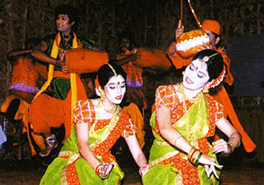
Folk dances in Bangladesh are mainly of three kinds: religious, social and cultural. Religious dances outnumber other forms. Dances relating to kirtan, penance, baul rites, gambhira, jari and fakir rites are associated with different religious beliefs and rituals. dhali and lathi dances are related to the martial arts, while chhokra, ghatu, and khemta dances provide entertainment. While some dances are influenced by Islamic beliefs and stories, others are inspired by Hindu myths and legends. Such dances attract participants and audiences mainly from their respective communities. However, some folk dances have universal appeal. For instance, while kirtan dance is enjoyed mainly by Hindus, and jari by Muslims, Lathi or dhali dances are enjoyed by both all. Although chhokra, ghatu and leto dances are mainly patronised by Muslims, their performances entertain all other communities.
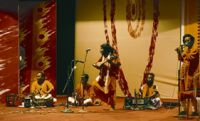
Baul dance forms part of the religious rites of bauls. Baul songs are spiritual in theme, and while singing these songs, bauls at one stage start dancing in ecstasy. They hold an ektara in their right hand. Some wear ghubur (a string of bells) round their ankles. Usually baul dances are performed by individuals, but at times they also perform duets or group dances at their akhda. Though while dancing, bauls shake their heads and locks of hair, or twirl around and move their arms and feet, there are no ritualised gestures. The ektara plays a prominent part in the dance, sometimes being held close to the ears, sometimes high up. This dance is mainly popular in kushtia and jessore districts of Bangladesh and Burdwan and Birbhum districts of West Bengal.
Chhau dance a kind of masked dance from the Purulia-Bankura region in West Bengal. This is a martial dance with shields, swords and sticks, and is based on the ramayana and mahabharata. The characters wear different masks and dresses in keeping with their roles of gods, demons or animals. The dancers are generally of strong build. Female roles are also played by men wearing women's dresses and ornaments. Chhau dances used to be held with a great deal of fanfare towards the end of Chaitra or the beginning of Baishakh on the occasion of shiva puja. Nowadays Chhau dances may be performed regardless of season or occasion. This dance is very popular among the Bagdis and Bhuiyas. In this warlike dance, the dancers jump around, kneel and suddenly rush towards their opponents. Deft movements of the head, neck, hands, upper torso and legs demonstrate different warlike stances. Leg work is very important. Whether performed individually or in a group, the dance is performed in a circular area round which the musicians sit, leaving a narrow passage for the dancers enter and exit. The main musical instruments are the drum and the shehnai. The dance opens with a hymn to ganesh and then a song of two lines to welcome the arrival of the artistes. Dance and music are more important here than singing.Ashutosh bhattacharya popularised this dance form.
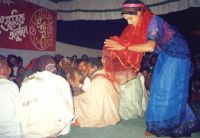
Chhokra dance (literally, dance by young boys) featuring youths playing the roles of women, accompanies alkap songs and has been in vogue in West Bengal's Murshidabad and Maldah region for a long time. This dance is performed on a canopied stage in a mango grove or in an open field. It is directed by a sarkar who leads a fairly large team of singers, musicians, and players. A clown also forms part of the troupe.
The musicians seat themselves on the sides of the stage and provide the music for the songs and dance. Others stay in the dressing room and wait their cue. Young boys dressed as girls take part in this dances as in the ghatu dance. Some parts of the alkap song and the chhokra dance can be quite vulgar and this is why performances are held late at night, for adult audiences. The story of Radha and Krishna is a popular theme for this brance of folk dance.
Dak dance is another battle dance, popular in Manikganj. Its object is to call fellow warriors to battle. The team leader calls out that the enemy has launched an attack. At the call, a number of dancers come running onto the stage. This part of the dance is known as dak or call. The second part is devoted to exhibiting martial skills with the help of sticks. The drum is the main musical instrument.
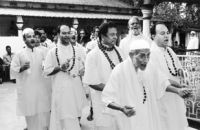
Dhali dance (literally, shield dance) enacts a duel between two men whose weapons are thickly woven cane shields and bamboo sticks. Drums and brass cymbals provide the musical accompaniment. The main objective of this dance is to display the dancers' physical prowess and martial skills. To start with, the two warriors face each other threateningly, in tune with the music, and then launch their attacks and counterattacks either standing or kneeling. This mock war goes on until a climax is reached. Dhali dance is usually arranged at folk fairs in Jessore and khulnaregions.
Fakir dance This dance is performed by the followers of Madar Pir on the occasion of his urs. Long-haired devotees, wearing long, loose garments, gather at the pir's mausoleum at the end of Chaitra (March-April) and burn candles and incense. A bamboo, draped in red with a fly-whisk on top, is dedicated to the pir as his symbol. One devotee carries the bamboo on his shoulder; others follow him. They wear bells round their ankles. A fire is lit and meat is burnt on it as offering to the pir. The devotees dance around the fire, swaying their heads to the beat of the music.
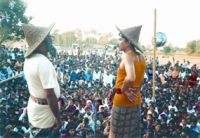
Gambhira dance This dance accompanies gambhira songs and used to be quite popular in the Maldah district of undivided Bengal. Though not as popular today as it was in the past, it continues to be performed in Rajshahi. The dance is performed by a pair of artistes, one acting the role of a nana (maternal grandfather) and the other that of his nati (grandson). Through their dancing and singing, they critique contemporary social, political, economic and moral problems. The dialogue is in both prose and verse. There is a chorus which repeats the refrain of the song. The main musical accompaniments are the harmonium, flute, drum and judi. The gambhira dance, with its mixture of dialogue, dance, songs and music, resembles a folk play. While the chorus sings the refrain, the nana and nati dance, with the nati wearing a string of bells round his ankles. In Maldah, the artistes wear masks.
Ghatu dance This dance accompanies ghatu songs. It has no religious or social contents, its object being solely to entertain the audience. One or more teenaged boys dressed as girls form its main attraction. The songs are usually based on the story of radha and krishna. One person sings while the others dance. Dances are also based on popular love stories. The drum, cymbals, the flute and the sarinda are the main musical instruments. These days the harmonium is also used. The dance goes on for long hours of the night. At times the dance becomes quite vulgar, which is why ghatu sessions are usually held outside populated localities.
Among the Kishoribhajan, a Vaishvava sub-sect, teenaged girls sing bhajans and dance. It is possible that ghatu songs and dances, based on the story of Radha and Krishna, were influenced by the Kishoribhajan. These days ghatu dances are performed on modern stages at Kishoreganj and netokona.

Jari dance This dance accompanies jari singing and is usually performed by shi’ah Muslims. It is organised during muharram and recounts the mournful death of Imam Hossain at Karbala. About 8-10 youths form a jari dance group. The leader of the group is called ustad and the others dohar. The dancers wear everyday garments but tie red handkerchiefs round their wrists and brows. In some areas they also wear strings of bells round their ankles. The ustad plays the chati and sometimes the dohars play the jharni, made of bamboo, to maintain the rhythm and keep up the beat. In some places the beat is maintained by clapping. The ustad stands in the centre and sings. The dohars move in a circle round him, singing the refrain of the song. The dancers express their grief by the movements of their heads, hands and feet. Jari dance performances start with the sighting of the Muharram moon. Jari groups go around different houses of the village. They are paid cash or given some food for their performances. On ashura the various dance groups assemble at a place designated as Karbala for a final performance.
Kali dance This dance is performed with the dancer wearing a black mask portraying the goddess Kali, with her characteristic protruding blood-red tongue. The dancer holds a falchion in one hand and a human skull in the other. The drum is the main musical instrument for this dance, which conveys both valour and cruelty.
Khemta dance accompanies khemta songs, which are based on the story of Radha and Krishna. Drums and cymbals form the musical instruments. Khemta dances may be performed on any occasion, and, at one time, were popular at weddings and pujas. Basically, this is a women’s dance, but in some areas eunuchs are associated with it and it is they who are still keeping this art alive. Khemta dances are characterised by complex foot movements and meaningful expressions of the eyes and the face. This entertaining dance may be called the rural version of the urban dance of baijis or professional women dancers.
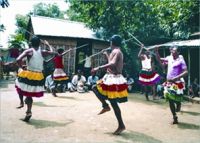
Lathi dance a stick dance performed during Muharram by groups of youths. Drums and brass cymbals are used to maintain the rhythm and tempo. The youths wear close-fitting garments and also at times tie strings of bells round their ankles. In their hands they carry bamboo sticks about four or five feet long. They also carry swords, daggers and cymbals. The lathi dance is half dance and half sport. With sticks and swords in their hands, the youths demonstrate their valour by way of a mock battle. They dexterously whirl their sticks, moving them to the front or to the sides, then under their legs or over their heads in time to the music. The fierce clashes of the sticks create a battle scene. The drummer plays an important role in this dance, guiding the moves, tempo and rhythm of the dancers. This dance is divided into several sections: an introduction, different warlike stances, the fight, resolution and rest. The tempo is slow initially but picks up and ends on a crescendo. For the first ten days of Muharram, the lathi players demonstrate their art in the courtyards of houses, at cross sections of roads and finally at the mock Karbala ground.
Leto dance is associated with leto songs and is popular in Burdwan and Birbhum. As in the chhokra dance, in this dance as well, a handsome boy dressed as a girl sings and dances. Leto dances are often performed at intervals during poetic contests to provide added entertainment to the audience. When kazi nazrul islam was young, he used to compose leto songs and take part in these performances.
Mask dances The gods Shiva, dharma thakur and Nil are worshipped during the last days of Chaitra. On the occasion of these pujas, dancers, wearing masks portraying different gods and goddesses, present songs and dances. In the bola dance, masked dancers demonstrate a corpse being eaten by vultures. In the nrsingha dance, masked dancers depict Vishnu in his fourth incarnation as a lion. In north Bengal there is a masked dance called mukhakhel for which villagers make their own masks with wood, cloth, paper etc. Characters range from kings and ministers to ordinary farmers and woodcutters. During droughts, the Rajbangshi women of Rangpur perform a rain dance during which they worship Huduma Deo, the rain god. They form a group and go out into the fields at night. There they perform a puja to Huduma Deo. Then they undress, dance and sing.

Puppet dance It is not known how old the tradition of puppets dances is in Bengal. The first reference to puppets is, however, found in yusuf-zulekha, a 15th century epic. There are three forms of puppets in Bengal: rod puppets, string puppets and glove puppets. The puppeteer manipulates string puppets with strings so that the puppets appear to be dancing. As the musicians play their drums, cymbals and flutes, an artist sings a song and makes the puppets dance to reflect the mood of the song.
Rod puppets and string puppets are used to present palagan or narrative plays, usually on the stories of Radha-Krishna and Rama-Sita. Such plays are also composed on contemporary social events. The primary purpose of these plays is didactic. However, they are also highly entertaining. In West Bengal, rod puppets are still popular in the 24 Parganas and string puppets in Nadia.
Glove puppets dance as a male-female pair. Some people of the kahar class in Midnapore and Burdwan of West Bengal earn their living through puppet dances. An artiste holds a puppet in each hand and sings while making the puppets dance. While stories from the purana are popular, the focus is on their entertainment value, not their religious significance. In the past, puppet dances used to be arranged at a child's annaprashana or at weddings. Puppet dances were quite popular in north Bengal, Mymensingh and Comilla, but after partition this folk art suffered a setback as many Hindu artistes left for West Bengal. These days only a handful of families in Brahmanbaria make a living out of this art.
Raybenshe dance a warlike dance similar to lathi dance. The dancers carry poles of strong bamboo known as raybansh. The warriors also use swords and spears. Both Hindus and Muslims take part in this dance which was mainly popular in Burdwan, Birbhum and Murshidabad. The main attraction of this dance lies in the dexterity with which artistes use their hands.
In addition to these traditional forms, there are modern folk dances which depict the Bangladeshi identity by portraying the lives of farmers and fishermen as well the role of ordinary people and freedom fighters during the liberation war. [Wakil Ahmed]
